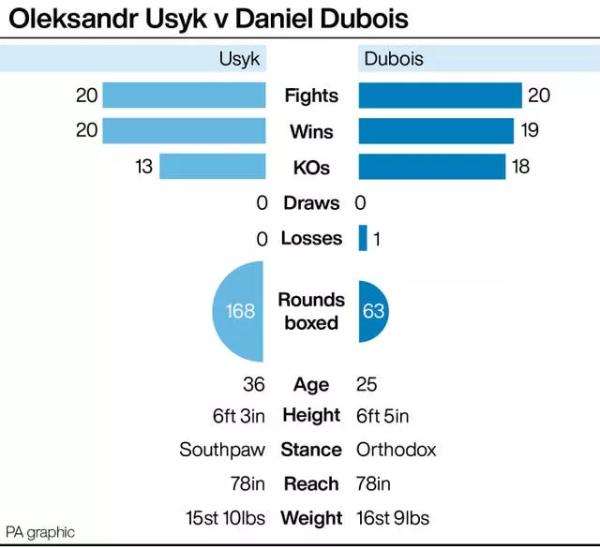
Daniel Dubois knows he will have to “bully” Oleksandr Usyk on Saturday night if he is to stand any chance of becoming Britain’s 10th world heavyweight champion.
Dubois (19-1, 18KOs) will attempt to etch his name into British history alongside Tyson Fury, Anthony Joshua and Lennox Lewis when he walks out at Tarczynski Arena in front of around 43,000 spectators.
Advertisement
Usyk’s WBA, IBF and WBO belts will be on the line and the Ukrainian (20-0, 13KOs) will be backed by a partisan crowd in Wroclaw, which will be filled with Ukraine natives who have resided in Poland since Russian’s invasion of their country last year.
The bookmakers make Dubois, 25, the overwhelming underdog but he tipped the scales at 16st and 9lbs at Friday’s weigh-in, almost a stone heavier than 36-year-old Usyk’s 15st and 10lbs.
Advertisement Advertisement
Both boxers have fought 20 times in the professional ranks but there is a big disparity in rounds with Dubois involved in 105 fewer than Usyk’s 168, which has contained plenty for a world title.
Nevertheless, all of Dubois’ bouts have been at heavyweight while the former undisputed world cruiserweight champion only stepped up to the blue-riband division in 2019.
Dubois told the PA news agency: “I have been boxing for most of my life so that (age) argument is out of the window. I have the experience and I need to be a veteran in this fight.
“I have to bully him. I have to go in there and be the bully. Be the bully and shake him up.”
Advertisement
The Londoner also has a secret weapon after joining forces with trainer Don Charles, who was in Derek Chisora’s corner when the British veteran caused Usyk problems in 2020.

“Yeah, Don will be putting in things that I am not even aware of style-wise and coach-wise. He has a lot of passion and that is what you need,” Dubois said.
Advertisement
“You need the bully-the-bull type mentality to go in there and f*** s*** up, as they say. That is what we need to do.”
Advertisement
Stablemate Tyson Fury will also act as inspiration for Dubois with Queensberry Promotions promoter Frank Warren able to draw parallels between this clash and a memorable world title fight in Dusseldorf in 2015.
Few gave Fury any chance when he stepped out to fight Wladimir Klitschko eight years ago but he produced an enormous shock to win on points and claim the belts now held by Usyk in his own first world title bout.
Dubois added: “All the great fighters had to do it. Before they were champions, people doubted them and had a lot of things to say.
“Boxing is made up of opinions so I never take it to heart or let it break me. I am ready to go. Ready to go out there and prove what I need to do.
“Tyson is a good example. Look at what he has done and gone on to achieve now. I just need to get the prayers going and hopefully the big man upstairs hears me.”
While most of the pre-fight focus has centred on whether a unification clash between Usyk and Fury could finally occur in 2024, the mandatory challenger wants to spoil a homecoming party of sorts in Poland.
Advertisement
After coming through the storm of his 2020 defeat to Joe Joyce, where he took a knee which allowed himself to be counted out in the 10th round due to a hugely swollen left eye, Dubois believes he now has a date with destiny.
“My dad especially backing me and being behind me has been paramount,” he said.
“This doesn’t happen often but I am ready for this opportunity and ready to perform. That is the main thing to perform on the night.
“Go out there and show everything I have done. All the hard work I have put in and my dad has put in over the years. It is finally time.”
Sourse: breakingnews.ie